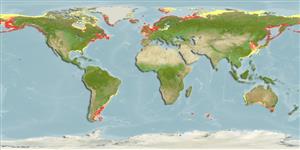Scyphozoa |
Semaeostomeae |
Cyaneidae
Environment: milieu / climate zone / depth range / distribution range
Ecology
Pelagic; depth range 0 - 85 m (Ref. 116114). Boreal; 81°N - 47°N, 34°W - 69°E
Arctic and Northeast Atlantic: from Iceland to France, north to Svalbard and east to Russia.
Length at first maturity / Size / Weight / Age
Maturity: Lm ? range ? - ? cm Max length : 229 cm WD male/unsexed; (Ref. 99323)
Diameter up to 100 cm; rhopalar and tentacular stomach pouches completely separated; peripheral canals more or less curved; without or with very few anastomoses; color reddish brown or yellowish.
The tentacle of the longest medusozoa meaures 36.6 m (Ref. 99323). The largest specimen observed was 2 meters wide (Ref. 121705). Estuarine, potentially pathogenic (Ref. 116114).
Life cycle and mating behavior
Maturity | Reproduction | Spawning | Eggs | Fecundity | Larvae
Members of the class Scyphozoa are gonochoric. Life cycle: Egg is laid by the adult medusa which later develops into a free-living planula, then to a scyphistoma to a strobila, and lastly to a free-living young medusa.
Cairns, S.D., D.R. Calder, A. Brinckmann-Voss, C.B. Castro, D.G. Fautin, P.R. Pugh, C.E. Mills, W.C. Jaap, M.N. Arai, S.H.D. Haddock and D.M. Opresko. 2003. (Ref. 1663)
IUCN Red List Status (Ref. 130435)
CITES status (Ref. 108899)
Not Evaluated
Not Evaluated
Threat to humans
Human uses
| FishSource |
Tools
Internet sources
Estimates based on models
Vulnerability
Very high vulnerability (90 of 100).
Price category
Unknown.
